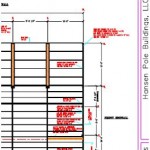Reader MICHAEL in EAGLE POINT writes:
“I want to span 18 feet on a shed roof with any pitch necessary should I nail two 2x 6 rafters together and place this in the center and use 9 foot 2×6 purlins. The shed will be 18 X 18. Do I need to nail two 2×6 together for the two outside rafters?
All spans are clear span no center post The high side of shed is up against an existing building the low side will be new post and beam or posts with the rafters bolted to the post
This is a shed with only two walls. The existing high side as explained and the new post and beam side as the low side The two other sides will be open to drive under.
I plan on three or four posts on the low side depending on whether I use beams post to post underneath the rafters Or Bolt the rafters to either side of the post and eliminate the beams.
Since I’m using 2 x 6 purlins between the rafters I wondered if I could span the 18 foot length using two 2 by sixes (nailed together )For rafters. Since I’m using purlins I thought I could only have the rafters at each end and one in the center keeping in mind it is only a metal roof.”
 Mike the Pole Barn Guru responds:
Mike the Pole Barn Guru responds:
This sort of armchair ‘engineering’ is far too typical of what I read in social media groups. When designs such as what is proposed are utilized, and buildings fail, folks are quick to point fingers as pole buildings being responsible, rather than lack of proper engineering design being our true culprit.
Please confirm this with your Registered Professional Engineer who will be sealing your building plans. Most of Oregon (your part included) has a minimum roof live load of 25 psf (pounds per square foot). For sake of discussion, we will use 3 columns spaced nine foot on center along low and high sides and a five psf dead load (just in case someone decides to add plywood or OSB under a reroof some day).
Moment force = (25 + 5) psf x (9′ distance to next rafter / 2 [1/2 distance to next rafter] x 12″) x 18’^2 [ span of rafter] / ( 8 x 1.15 [Cd = duration of load for wood]) = 57,052.17 in-lbs
57,052.17 / (2 x 31.6406 [Section Modulus of a 2×12]) = 901.57 Fb [fiberstress in bending] required
2×12 #2 DougFir has a Fb of 900, so given bearing width at each end would most likely be approved by your engineer.
For rafters I would recommend a 2 ply 2×12 #2 DougFir on each end, and at center use two rafters on each side of the column. Connection at ends must be capable of withstanding 1215# so a single bolt will be nowhere near adequate (again, your engineer will properly design and detail this connection). Your thought of nailing two 2×6 together would be woefully inadequate (and would be over 300% over stressed probably failing during construction).
Hiring a Registered Professional Engineer is not an expense, it is an investment.








I am planning right now. Wisconsin res check is required. Do you sell engineered plans with electric plumbing hvac all included?
You can get floor plans & elevation drawings through this link: http://www.hansenpolebuildings.com/post-frame-floor-plans/?fbclid=IwAR2ta5IFSxrltv5eAyBVmg-JUsoPfy9hbWtP86svOTPfG1q5pGmfhA7yd5Q
For an extra fee they can include electrical, plumbing and HVAC however your providers will completely ignore these. Qualified providers of these services should provide those layouts as part of their service (and then they will actually match).
We provide complete and fully engineered structural plans with each of our buildings.